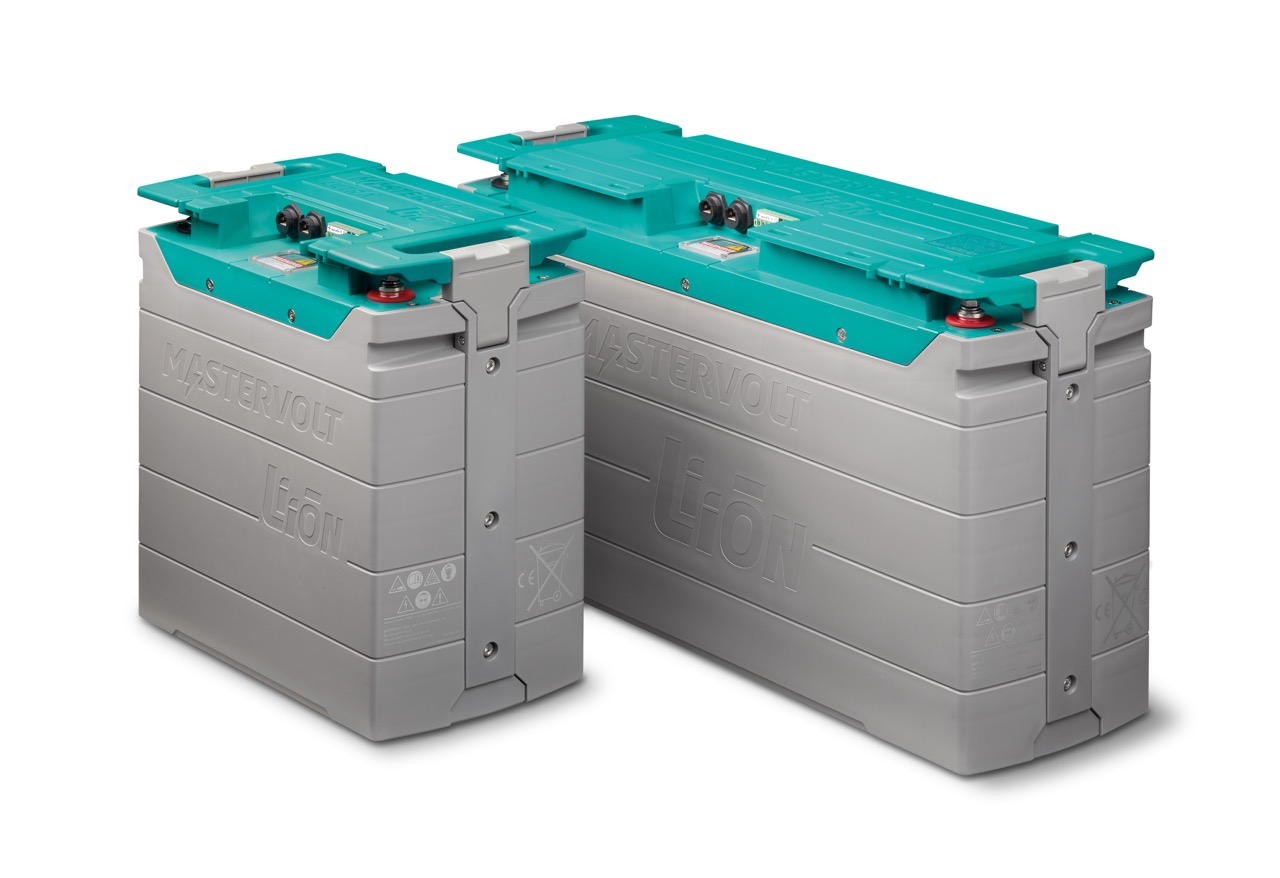Getting Technical: The lithium lowdown, a peek at the future of lithium batteries

Battery technology is improving and expanding. For boatbuilding purposes, there’s a lot in the works that is promising
As part of a well-engineered system, lithium batteries can replace generators and make life on a boat seamless with or without shore power. But they aren’t perfect. The battery industry continues to research improvements and alternative chemistries.
Here’s an overview of those new technologies and how they might affect the
boatbuilding industry.
The lion’s share of battery development focuses on the electric vehicle market and on improving range, as well as the time it takes to charge the car. The use scenario aboard boats — primarily as deep cycle batteries for house systems and trolling banks — is generally far less demanding.
Lithium-based chemistries have dominated new battery technologies for quite a while. Lithium is the lightest metal element and is highly reactive. It is lithium’s reactivity that makes it a critical ingredient in energy-dense batteries. In boatbuilding, especially for house battery systems, there’s a focus on lithium-iron-phosphate batteries.

These LiFePO4 batteries have excellent safety characteristics, good power density, low self-discharge and long lives with minimal capacity loss. Compared with lead-acid batteries, they deliver three to five times the energy density, 10 times the cycle life and two to three times the calendar life. They don’t off-gas, and they have no caustic, spillable electrolyte.
Although LiFePO4 is the safest and most stable of the mainstream lithium-based batteries, it isn’t the only chemistry used on boats. Lithium nickel-manganese-cobalt -oxide batteries are often used in electric propulsion systems.
During the pandemic’s supply-chain difficulties, lithium availability was constrained. China is the world’s main refiner of lithium. Supply-chain shortages drove the price of refined lithium up significantly and increased the focus on potential alternatives to lithium. Sources I’ve spoken with at Dragonfly Energy and Navico Group say they are primarily watching developments in sodium, solid state and lithium-manganese-iron-phosphate batteries.
Sodium Batteries
Currently, the most promising lithium alternative chemistry is sodium-iron-phosphate. As the name implies, sodium replaces lithium in a conceptually similar battery to a LiFePO4. Sodium batteries are less energy dense than lithium, but they are also less thermally sensitive. That reduced thermal sensitivity makes them even safer than LiFePO4 batteries.
As a raw material, sodium is far more plentiful than lithium. Over time, the greater availability of sodium will likely result in lower prices for sodium batteries. But for that to happen, sodium batteries will have to reach the kind of mature, large-scale commercial production that lithium batteries have today.
Because of their lower energy density, sodium batteries aren’t as well-suited to EV propulsion as lithium batteries. But for energy storage roles, their increased safety, abundant raw materials and potentially lower cost should make them competitive in applications where maximum energy density isn’t required.
Solid-State Cells
One of the drawbacks of current LiFePO4 battery technology is flammability. The flammable component in these batteries is the liquid electrolyte. In a lithium battery, the electrolyte allows lithium ions to move between the anode and cathode or vice versa. It is this movement that provides power or accepts charge back into the battery.
Current electrolyte technology uses a porous polymer barrier to prevent the cathode and anode from shorting, and to contain the liquid electrolyte. Solid-state cells replace the separators and liquid electrolyte with a solid electrolyte. There are myriad benefits to a solid electrolyte, including low or non-flammability, no leakage potential, mechanical and thermal stability, low self-discharge, higher power density and cycle durability.
The challenge in developing solid-state cells is finding a solid electrolyte that matches the current liquid electrolytes’ ability to diffuse lithium ions. Some early solid-state electrolytes utilize additives to increase the diffusion of lithium ions through the electrolyte. While increasing the battery’s efficiency, these additives also result in some flammability.
There are several solid-state battery cells in the marketplace, but they contain additives to ease the diffusion of lithium ions. As a result, although greatly reduced, their electrolytes are still somewhat flammable.
Although challenges remain with solid-state cells, there is a great deal of promise in the technology. Several EV manufacturers point to solid-state cells as an enabling technology to cost-effectively increase range more than 500 miles.
Lithium-Manganese-Iron-Phosphate
For nearly a decade, battery manufacturers have been experimenting with adding manganese to the lithium iron phosphate cathodes of LiFePO4 batteries. The resulting lithium manganese iron phosphate cells perform similarly to LiFePO4 cells, but with a few meaningful improvements.
The addition of manganese results in a higher-voltage cell with the same amp-hour capacity. The result is a cell with 15% to 20% more capacity. Additionally, LMFP cells are more tolerant of cold-weather operations. LiFePO4 cells lose capacity as temperatures drop and must be heated to be charged in cold conditions. LMFP decreases the power lost at cold temperatures and drops the temperature at which external heating must be applied.
It also remains early days for LMFP cells. A few cell manufacturers have begun production, and there are early deployments of the technology in EVs. Currently, LMFP batteries are about 5% cheaper per watt hour than a LiFePO4 battery, but that gap may widen as LMFP production techniques mature.
Because LMFP cells operate at an increased voltage, the math to produce 12 volts is difficult. Twelve-volt LiFePO4 batteries are composed of four cells with a nominal voltage of 3.2 volts each, making the pack 12.8 volts nominal.
LMFP cells have a voltage range between 3.45 and 4 volts per cell. That means four-cell LMFP batteries could produce 16 volts, or three-cell batteries would top out at 12 volts. Neither of these solutions is ideal.
However, as system voltages move higher to 24 or 48 volts, the cell math works fine. In my conversation with Navico Group, sources commented that this math dovetails nicely with the trend in new boats toward higher-voltage house systems. Hence, it is likely that LMFP will see greater adoption for higher-voltage systems.
Timeframe
Navico Group doesn’t expect to see any of these options in its product offerings for about three years. All three technologies are being evaluated, but until they are thoroughly tested, they still need to earn confidence in terms of longevity and safety.
However, cell manufacturers are beginning to offer cells built on all three technologies. We already have the first examples of battery manufacturers offering products based on these technologies. LiFePO4 has been in the market for well more than a decade and only really taken hold in the past handful of years. I expect that although adoption of these technologies will be faster, we are still three to five years away. However, we also haven’t fully harvested the potential of LiFePO4. Battery density continues to increase, manufacturers continue to refine their products, and the products that reach consumers continue to improve. With concerns about lithium availability easing, it appears there is time for new technologies to develop while the current ones are refined.













Super informative and interesting.
Has there been any discussion of LiS – lithium-sulfur? That seems to be an option closer than 3yrs out.
None of the battery manufacturers or researchers I spoke with mentioned any active efforts with lithium sulfur batteries. My own research for this article suggested limited commercial enthusiasm for the technology because of limited cycle life and durability concerns.
-Ben S.
Are any of the chemistries even lighter weight per KWh than the batteries we have today, either because they are more energy dense or require lighter cases?
I upgraded batteries for a 600AH system to LiFePO4 and was shocked to discover the ignorance and outright fear that the local marine electricians have of anything lithium. The industry has a serious training challenge to get the
Typical marine electrician competent to install these.